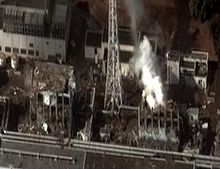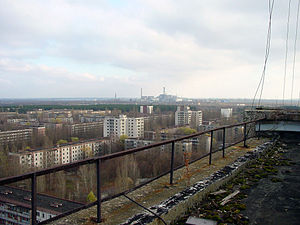- Nuclear and radiation accidents by country
-
This is a List of nuclear and radiation accidents by country.
This list only reports the proximate confirmed human deaths and does not go into detail about ecological, environmental or long term effects such as birth defects or permanent loss of habitable land.
Contents
Brazil
- September 13, 1987 – Goiania accident. Eleven fatalities and 320 other people received serious radiation contamination.[2]
Canada
- December 12, 1952 – The NRX accident.
- May 24, 1958 – The NRU accident.
- February 20, 1990 – Daniel George Maston placed a sample of heavy water into a "sport mix" drink dispenser in an industrial lunch zone.
Costa Rica
- 1996 – Radiotherapy accident in Costa Rica. Thirteen fatalities and 114 other patients received an overdose of radiation.[3]
Greenland
- January 21, 1968 – Thule accident.[4]
India
- April 2010 – Mayapuri radiological accident. One fatality.[5]
Japan
- March 1, 1954 – Daigo Fukuryū Maru, one fatality.
- September 30, 1999 – Tokaimura nuclear accident, nuclear fuel reprocessing plant, two fatalities.[6]
- August 9, 2004 – Mihama Nuclear Power Plant accident. Hot water and steam leaked from a broken pipe. The accident was the worst nuclear disaster of Japan up until that time, excluding Hiroshima and Nagasaki. Five fatalities.[6]
- March 12, 2011 – Fukushima. Level 7 nuclear accident on the INES. Three of the reactors at Fukushima I overheated, causing meltdowns that eventually led to explosions, which released large amounts of radioactive material into the air.[7]
Mexico
- 1962 – Radiation accident in Mexico City, four fatalities.
==Morocco==)
- March 1984 – Radiation accident in Morocco, eight fatalities.[8]
Panama
- August 2000 to March 2001 – Instituto Oncologico Nacional of Panama; 17 patients receiving treatment for prostate cancer and cancer of the cervix received lethal doses of radiation.[9][10]
Soviet Union/Russia
- September 29, 1957 – Mayak nuclear waste storage tank explosion at Chelyabinsk. Two hundred plus fatalities and this figure is a conservative estimate; 270,000 people were exposed to dangerous radiation levels. Over thirty small communities had been removed from Soviet maps between 1958 and 1991.[11] (INES level 6).[12]
- July 4, 1961 – Soviet submarine K-19 accident. Eight fatalities and more than 30 people were over-exposed to radiation.[13]
- May 24, 1968 – Soviet submarine K-27 accident. Nine fatalities and 83 people were injured.[10]
- 5 October 1982 – Lost radiation source, Baku, Azerbaidjan, USSR. Five fatalities and 13 injuries.[10]
- August 10, 1985 – Soviet submarine K-431 accident. Ten fatalities and 49 other people suffered radiation injuries.[14]
- April 26, 1986 – Chernobyl disaster. See below in the section on Ukraine. In 1986, the Ukrainian SSR was part of the Soviet Union.
- April 6, 1993 – accident at the Tomsk-7 Reprocessing Complex, when a tank exploded while being cleaned with nitric acid. The explosion released a cloud of radioactive gas (INES level 4).[12]
Spain
- January 17, 1966 – 1966 Palomares B-52 crash.[15]
- December 1990 – Radiotherapy accident in Zaragoza. Eleven fatalities and 27 other patients were injured.[13]
Thailand
- February 2000 – Three deaths and ten injuries resulted in Samut Prakarn when a radiation-therapy unit was dismantled.[5]
Ukraine
The abandoned city of Pripyat, Ukraine with the Chernobyl nuclear power plant in the distance.
- April 26, 1986 – Chernobyl disaster. Fifty-six direct deaths (47 accident workers, and nine children with thyroid cancer), and it is estimated that there were 4,000 extra cancer deaths among the approximately 600,000 most highly exposed people.[16][17][18]
United Kingdom
- October 8, 1957 – Windscale fire ignites plutonium piles and contaminates surrounding dairy farms, 33 cancer deaths.[19][20][19]
United States
- August 21, 1945 – Harry K. Daghlian, Jr died at Los Alamos National Laboratory in New Mexico.
- May 21, 1946 – Louis Slotin died.
- December 30, 1958 – Cecil Kelley criticality accident, at the Los Alamos National Laboratory.[21]
- 1961 – (US Army) SL-1 accident resulted in three fatalities.
- December 18, 1970 – After the Baneberry test at Yucca Flat, radioactive debris vented into the atmosphere, and 86 workers at the site were exposed to radiation.
- 1974-1976 – Columbus radiotherapy accident, 10 deaths and 88 injuries.[22][10]
- 1979 – Three Mile Island accident in Pennsylvania. Partial core meltdown, making it the most significant accident in U.S. history. No fatalities.[23]
- 1980 – Houston radiotherapy accident, 7 deaths.[22][10]
-
This list is incomplete; you can help by expanding it.
See also
- Atomic bombings of Hiroshima and Nagasaki
- Lists of nuclear disasters and radioactive incidents
- Nuclear and radiation accidents
- Nuclear power accidents by country
- Nevada Test Site
- Radium Girls
- Semipalatinsk Test Site
References
- ^ Tomoko Yamazaki and Shunichi Ozasa (June 27, 2011). "Fukushima Retiree Leads Anti-Nuclear Shareholders at Tepco Annual Meeting". Bloomberg. http://www.bloomberg.com/news/2011-06-26/fukushima-retiree-to-lead-anti-nuclear-motion.html.
- ^ The Radiological Accident in Goiania p. 2.
- ^ Medical management of radiation accidents pp. 299 & 303.
- ^ Thule Accident, January 21, 1968 TIME magazine.
- ^ a b Pallava Bagla. "Radiation Accident a 'Wake-Up Call' For India's Scientific Community" Science, Vol. 328, 7 May 2010, p. 679.
- ^ a b Benjamin K. Sovacool. A Critical Evaluation of Nuclear Power and Renewable Electricity in Asia, Journal of Contemporary Asia, Vol. 40, No. 3, August 2010, p. 399.
- ^ Martin Fackler (June 1, 2011). "Report Finds Japan Underestimated Tsunami Danger". New York Times. http://www.nytimes.com/2011/06/02/world/asia/02japan.html?_r=1&ref=world.
- ^ Lost Iridium-192 Source
- ^ Investigation of an accidental Exposure of radiotherapy patients in Panama - International Atomic Energy Agency
- ^ a b c d e Johnston, Robert (September 23, 2007). "Deadliest radiation accidents and other events causing radiation casualties". Database of Radiological Incidents and Related Events. http://www.johnstonsarchive.net/nuclear/radevents/radevents1.html.
- ^ Samuel Upton Newtan. Nuclear War I and Other Major Nuclear Disasters of the 20th Century 2007, pp. 237–240.
- ^ a b Timeline: Nuclear plant accidents BBC News, 11 July 2006.
- ^ a b Strengthening the Safety of Radiation Sources p. 14.
- ^ The Worst Nuclear Disasters
- ^ Palomares Incident, January 17, 1966 TIME magazine.
- ^ "IAEA Report". In Focus: Chernobyl. http://www.iaea.org/NewsCenter/Focus/Chernobyl/. Retrieved 2008-05-31.
- ^ Benjamin K. Sovacool. The costs of failure: A preliminary assessment of major energy accidents, 1907–2007, Energy Policy 36 (2008), p. 1806.
- ^ Benjamin K. Sovacool. A Critical Evaluation of Nuclear Power and Renewable Electricity in Asia, Journal of Contemporary Asia, Vol. 40, No. 3, August 2010, p. 396.
- ^ a b Benjamin K. Sovacool. A Critical Evaluation of Nuclear Power and Renewable Electricity in Asia, Journal of Contemporary Asia, Vol. 40, No. 3, August 2010, p. 393.
- ^ Perhaps the Worst, Not the First TIME magazine, May 12, 1986.
- ^ McInroy, James F. (1995), "A true measure of plutonium exposure: the human tissue analysis program at Los Alamos", Los Alamos Science 23: 235–255, http://library.lanl.gov/cgi-bin/getfile?23-11.pdf
- ^ a b Ricks, Robert C. et al. (2000). "REAC/TS Radiation Accident Registry: Update of Accidents in the United States". International Radiation Protection Association. p. 6. http://www.irpa.net/irpa10/cdrom/00325.pdf.
- ^ Stencel, Mark. "A Nuclear Nightmare in Pennsylvania", The Washington Post, March 27, 1999. Accessed July 5, 2010.
External links
- The Worst Nuclear Disasters TIME magazine
Radiation poisoning General Conditions Radiation dermatitis · Radiation recall reaction · Radiation acne · Radiation cancer · Radiation-induced lung injuryTreatments Categories:- Nuclear accidents
- Nuclear history
- Nuclear safety
- Radioactivity
- Nuclear technology-related lists
Wikimedia Foundation. 2010.


